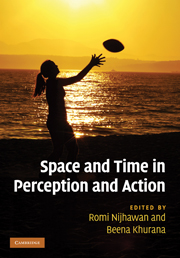Book contents
- Frontmatter
- Contents
- List of contributors
- Acknowledgments
- 1 Space and time: the fabric of thought and reality
- Part I Time–space during action: perisaccadic mislocalization and reaching
- Part II Temporal phenomena: perception
- Part III Temporal phenomena: binding and asynchrony
- Part IV Spatial phenomena: forward shift effects
- 19 The Fröhlich effect: past and present
- 20 Approaches to representational momentum: theories and models
- 21 Conceptual influence on the flash-lag effect and representational momentum
- 22 Perceptual asynchronies and the dual-channel differential latency hypothesis
- 23 Paying attention to the flash-lag effect
- 24 Illusions of time, space, and motion: flash-lag meets chopsticks and reversed phi
- 25 Bridging the gap: a model of common neural mechanisms underlying the Fröhlich effect, the flash-lag effect, and the representational momentum effect
- 26 Perceiving-the-present and a unifying theory of illusions
- 27 History and theory of flash-lag: past, present, and future
- Part V Space–time and awareness
- Index
- References
27 - History and theory of flash-lag: past, present, and future
from Part IV - Spatial phenomena: forward shift effects
Published online by Cambridge University Press: 05 October 2010
- Frontmatter
- Contents
- List of contributors
- Acknowledgments
- 1 Space and time: the fabric of thought and reality
- Part I Time–space during action: perisaccadic mislocalization and reaching
- Part II Temporal phenomena: perception
- Part III Temporal phenomena: binding and asynchrony
- Part IV Spatial phenomena: forward shift effects
- 19 The Fröhlich effect: past and present
- 20 Approaches to representational momentum: theories and models
- 21 Conceptual influence on the flash-lag effect and representational momentum
- 22 Perceptual asynchronies and the dual-channel differential latency hypothesis
- 23 Paying attention to the flash-lag effect
- 24 Illusions of time, space, and motion: flash-lag meets chopsticks and reversed phi
- 25 Bridging the gap: a model of common neural mechanisms underlying the Fröhlich effect, the flash-lag effect, and the representational momentum effect
- 26 Perceiving-the-present and a unifying theory of illusions
- 27 History and theory of flash-lag: past, present, and future
- Part V Space–time and awareness
- Index
- References
Summary
Summary
Some basic versions of the flash-lag effect have been known since the early decades of the twentieth century. Intriguingly, neural delays were as central in the early attempts at explaining the effect, as they are in the more recent investigations into its cause. For a changing visual stimulus a delayed registration of the stimulus by the central nervous system (CNS) constitutes an “error” between the instantaneously registered state of the stimulus on the one hand and its physical state on the other. Therefore, for animals to acquire food, mate, and avoid predators, compensation of sensory delays is essential. One may ask which component(s) of the CNS compensate for visual delays. Logically compensation could be carried out either by visual or motor mechanisms, or both. The motion extrapolation account of the flash-lag effect challenged the dominant view that only motor mechanisms compensate for visual delays, suggesting instead that visual mechanisms also contribute. Controversy fueled by empirical observations with unpredictable motion, in particular the flash-initiated and flashterminated conditions of the flash-lag effect, soon followed; prima facie motion extrapolation could not accommodate these results. Armed with these challenging findings (primarily) several alternative accounts of flash-lag were proposed. In light of new developments, this chapter evaluates the motion extrapolation, motion sampling, motion integration, postdiction, differential latency, and attentional cuing accounts of flash-lag.
- Type
- Chapter
- Information
- Space and Time in Perception and Action , pp. 477 - 500Publisher: Cambridge University PressPrint publication year: 2010
References
- 7
- Cited by

